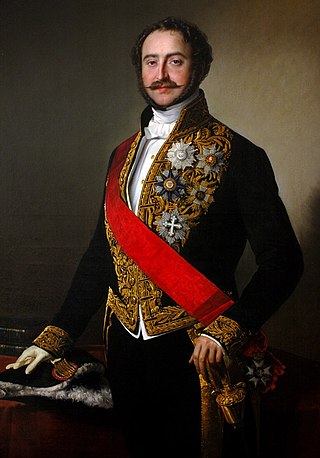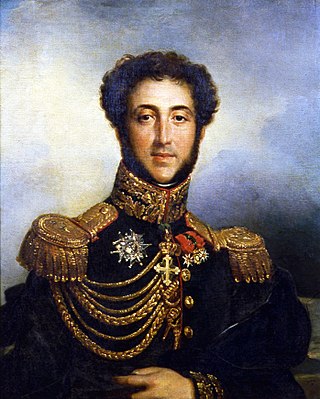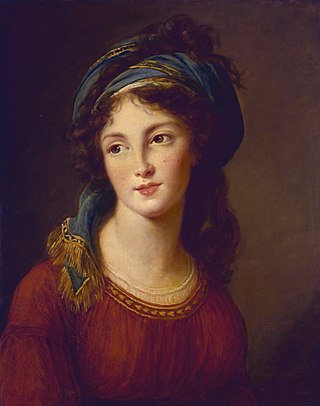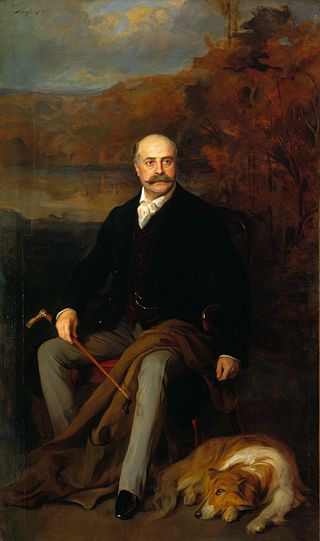
The House of Gramont is the name of an old French noble family, whose name is connected to the castle of Gramont (Agramont in Spanish) Basque province of Lower Navarre, France. [1]

The House of Gramont is the name of an old French noble family, whose name is connected to the castle of Gramont (Agramont in Spanish) Basque province of Lower Navarre, France. [1]

Philibert, Count de Gramont (1621–1707), was a French courtier and soldier, known as the protagonist of the Mémoires written by Anthony Hamilton. He was a younger half-brother of Antoine III of Gramont and uncle of Catherine Charlotte de Gramont, princess of Monaco.

Agénor de Gramont, 10th Duke of Gramont was a French diplomat and statesman who also had the title Prince of Bidache.
The title of Duke of Gramont is a French dukedom and former peerage. It was created in 1648 for French Marshal Antoine III de Gramont.

Jacques Henri de Durfort, 1st Duke of Duras was Marshal of France.
A Colonel General was an officer of the French army during the Ancien Régime, the French Revolution, the Napoleonic era and the Bourbon Restoration.

Antoine de Gramont, 2nd Duke of Gramont,comte de Guiche,comte de Gramont,comte de Louvigny,Souverain de Bidache was a French military commander and diplomat. He served as Marshal of France from 1641, Viceroy of Navarre and Béarn, and Governor of Bayonne.

Antoine Charles de Gramont, 3rd Duke of Gramont was a French nobleman comte de Guiche,comte de Louvigny,Souverain de Bidachewho served as a diplomat. His senior title was Duke of Gramont.

Guy Armand de Gramont, Count of Guiche, was a French nobleman, adventurer and one of the greatest playboys of the 17th century.

Héraclius de Gramont, 9th Duke of Gramont, 9th Duke of Gramont, Duke of Guiche, Prince of Bidache, etc. was a 19th-century French aristocratic Army general and courtier.

Marie Victoire Sophie de Noailles, Countess of Toulouse, was a French noble and courtier. Her second spouse was Louis Alexandre de Bourbon, Count of Toulouse, the youngest legitimized son of King Louis XIV of France and his maîtresse-en-titre, Madame de Montespan.

Aglaé Louise Françoise Gabrielle de Polignac was the daughter of Gabrielle de Polastron, the favourite and confidante of Marie Antoinette, and her husband, the 1st duc de Polignac.

Antoine Louis Marie de Gramont, 8th Duke of Gramont, was the 8th Duke of Gramont, he was also Prince of Bidache. Antoine served as a French military officer, diplomat and parliamentarian.

Armand Antoine Agénor de Gramont, 12th Duke of Gramont was a French nobleman, scientist and industrialist. He was known by the courtesy title of Duke of Guiche until 1925, when he succeeded his father as Duc de Gramont.

Countess Élaine Marie Joseph Charlotte de Greffulhe, who became the Duchess of Gramont by marriage, was a French aristocrat. She was a descendant of Hortense Mancini through her granddaughter's Pauline Félicité de Mailly son Charles de Vintimille, duc de Luc.

Antoine I d'Aure de Gramont, viscount of Aure, count of Guiche, sovereign-lord of Bidache was a French courtier and general. He served as gentleman in ordinary to the king's chamber from 1559 to 1564, serving Henry II, Francis II and Charles IX in that role.

Antoine de Gramont, 1st Duke of Gramont (1572–1644) was a member of minor French nobility by birth. Created the 1st Duke of Gramont in 1643 by King Louis XIV, he was automatically a Peer. His granddaughter Catherine Charlotte de Gramont married Louis I, Prince of Monaco, making Antoine a direct ancestor of the present reigning Albert II of Monaco. Though created the 1st Duke of Gramont, the creation of the title was not officially registered in Parliament before his death, so his son had to petition for the dukedom to be recognised. His mother had been royal mistress of King Henri III of Navarre between 1582 and 1591.

The Château de Vallière is a 19th-century château located in Mortefontaine, in the Oise département, in the Hauts-de-France region. The park is partly located in the commune of Fontaine-Chaalis. Built in 1894 in neo-Gothic style for the Duke of Gramont, its facades and roofs are listed in the supplementary inventory of historical monuments by decree of 29 October 1975. The park, located on the edge of the Ermenonville Forest, has been a listed site since 10 April 1961.

Antoine Alfred Agénor de Gramont, 11th Duke of Gramont, known as the Duke of Guiche from 1855 to 1880, was a French aristocrat, soldier and landowner.

Antoine Agénor Henri Armand de Gramont, 13th Duke of Gramont, known as the Duke of Guiche from 1925 to 1962, was a French aristocrat and landowner.